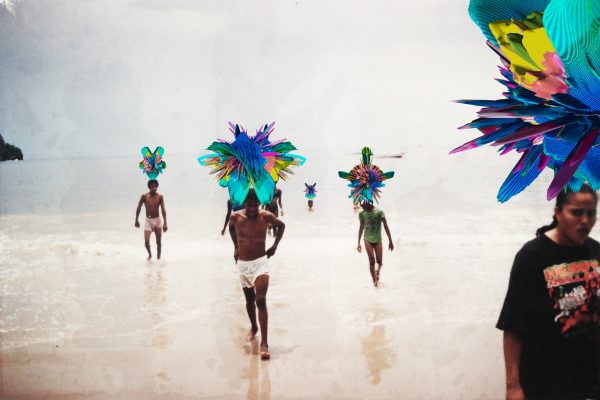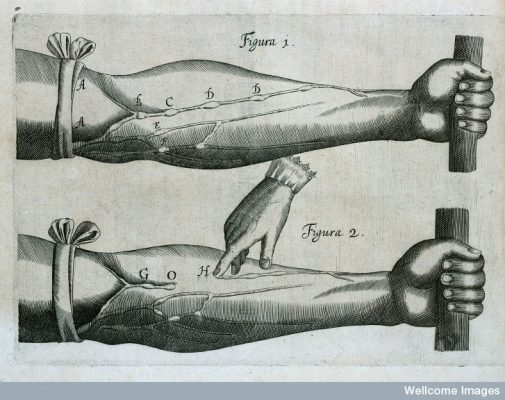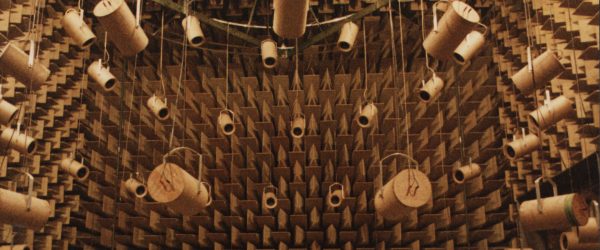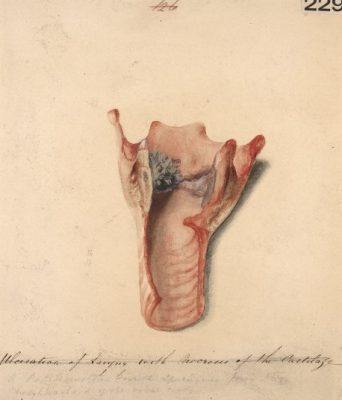Not long after I moved into my first apartment, I started keeping an archive.
By ‘archive’ I mean a shoebox under the bed. Those were days when it was hard to believe anyone would ever care who I was, where I had come from, or where I was going. I had quit my day job as a journalist and decided to devote myself completely to my life as a poet and a writer, but, unsurprisingly, the path was far from straightforward. For a long time, the box stayed empty, collecting dust as, night after night, I dreamt in the bed above.
One day all that changed, when I was commissioned to write about Caribbean writers and their literary archives. The project showed me how the most meaningful things in life can be fragile and ephemeral, and that, without a record somewhere, all of that substance can vanish like a forgotten memory.
The shoebox filled. Then it was replaced with a plastic container I got from Excellent City Centre on Frederick Street, Port of Spain, Trinidad. Soon, one container was not enough: I got three more. I started to keep everything: books, printed programmes, flyers. I had a boyfriend who would make jokes about this. One day I drank a bottled water at a literary panel at a university. He kept the bottle and later said, ‘For the archive?’ We broke up not long after.
Anybody who was interested in art in Port of Spain during this period – the late 2000s to the late 2010s – would have encountered my friend Rodell Warner. I remember going to events and picking up his sleek, intriguing zines, some of which made it into my archives just because. My apartment was in Belmont, where Warner is originally from, near to all the free art spaces in the capital. I went to all of the exhibitions and film screenings I could, was in awe of Caribbean talent, gave or attended poetry readings, flirted with boys, drank too much, felt on the brink of possessing important knowledge, quoted Derrida too often, anticipated the dawn of a new era, and walked into shows by Rodell Warner. He’d project colourful, kinetic patterns into dark, smoky spaces and people would take photographs, images that froze a fleeting euphoria. Warner’s show at Tern Gallery in the Bahamas in the spring of 2021, AUGMENTED ARCHIVES, brought all this back to me: the innocence of his explorations of new technology, the colour and animation of his illustrations, the mesmerism of his sounds and infinite loops which hum to the chaos of a tropical city that is at once beguiling and terrifying. In a sense, his work is an archive of a specific moment for me, for us.
*
Warner works primarily in new media – making digital interventions of all kinds, from GIFs to poetic tweets – and photography. His show at Tern Gallery comprised three strands of his recent output, most prominently AUGMENTED ARCHIVE (2020) which showcased his deep engagement with archives as a technology of power.

In AUGMENTED ARCHIVE, found antique photographs, many of which are traceable to the era of European colonialism in the Caribbean, are manipulated. Much in the way that old paintings and film reels can be ‘restored’ by having their surfaces expertly treated, Warner turns black and white images into colour through the use of image augmentation software, which utilises AI to examine and analyse photographs in order to render them afresh. Strange, luminous objects are also inserted into the frames: floating like lilies on a lake, or like the flaming, blood-sucking soucouyants of Trinidad folklore, who take flight at night in the form of ghostly balls of fire, before resuming human form at dawn by putting on a human skin.
The result is disconcerting. ‘Augmented Archive 001’ (2020) is based upon a photograph of a child guiding two donkeys through water in a lush grove. The scale of the image, the large size of the coconut trees, emphasises the child’s diminutiveness. Given the colonial context, any sense of a childhood idyll is soon supplanted by notions of forced labour and cruelty. Warner inserts a soucouyant-like object in the line of sight of the child, who appears, in the augmented composition, entranced. Where the child is going, coming from or being led is not clear. Nor do we know if the land has flooded, if this is a coastal marshland or a river being crossed. The rich colouring of the image, which Warner has used to create a dark green, cavernous backdrop, instills a sense of foreboding.
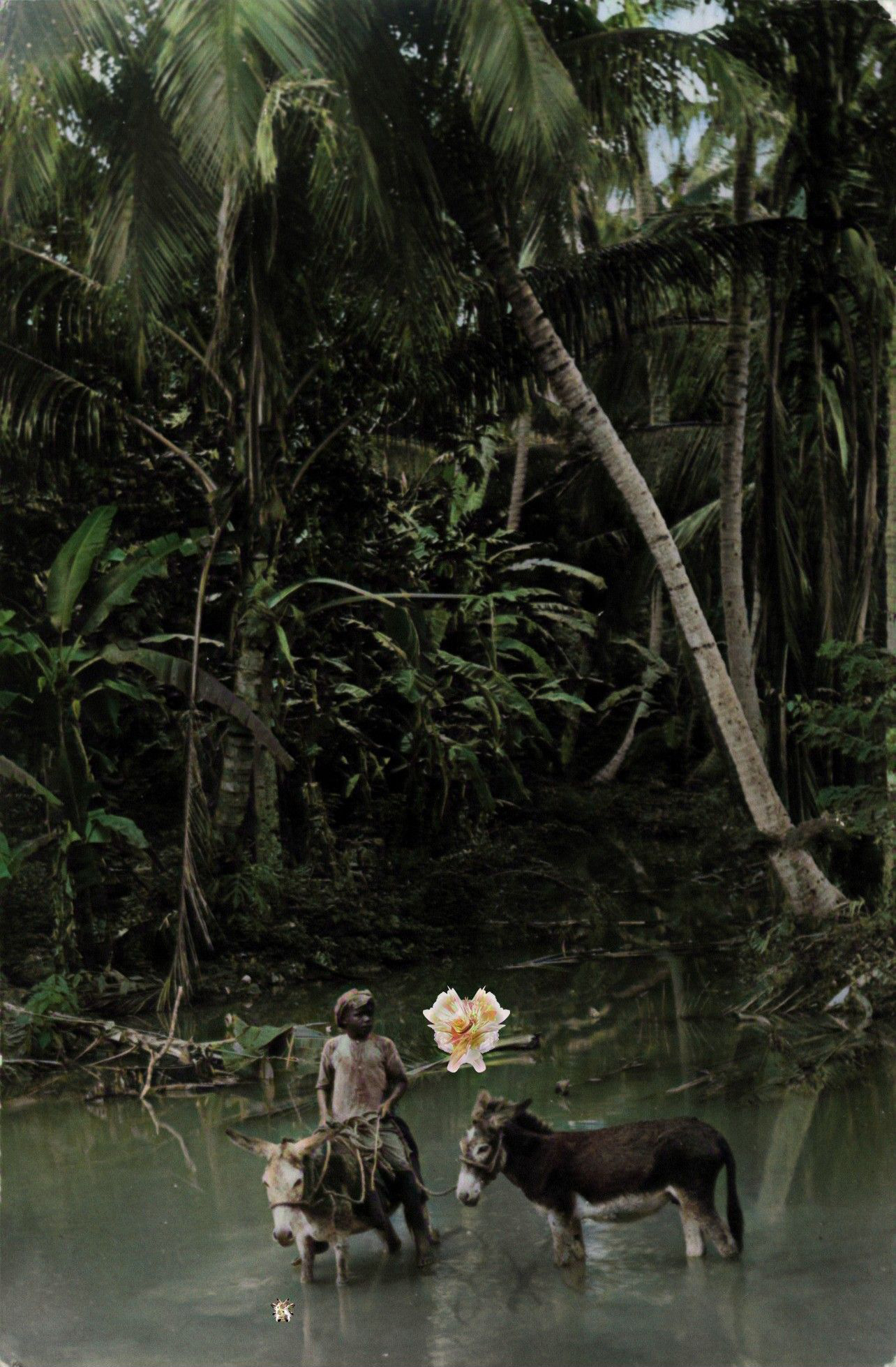
Warner’s interventions wilfully interrupt the touristic and demeaning nostalgia that archival images sometimes traffic in. They are an invitation to reorient our focus when considering history’s sepia tones. ‘My intention is really to invite people to find what they might see in these colourised, digitised, perhaps fictionalised versions of rare images from the Caribbean’s past,’ Warner has said of his work. ‘I am making things that invite the viewer to imagine more about the lives of the people.’
*
Other images in AUGMENTED ARCHIVE also bring to mind the history of colonialism within the Caribbean, a history which involved the processes of slavery and East Indian indentureship. Some five million enslaved Africans were taken to the Caribbean, almost half of whom were shipped to the British Caribbean from the seventeenth century onwards. After emancipation, indentured labourers were trafficked from India and elsewhere in order to work on sugar plantations during the nineteenth century. This process of indentureship only ended in 1917, a few decades before the islands were granted independence. Many of the archival images found by Warner do not specify when they were taken. Nor are the subjects or photographers named. It is almost as though, as Warner stated in an interview published in the Trinidad and Tobago Newsday, what mattered most was the work being done by the individuals in the images, their place within the cogs of a colonial wheel.
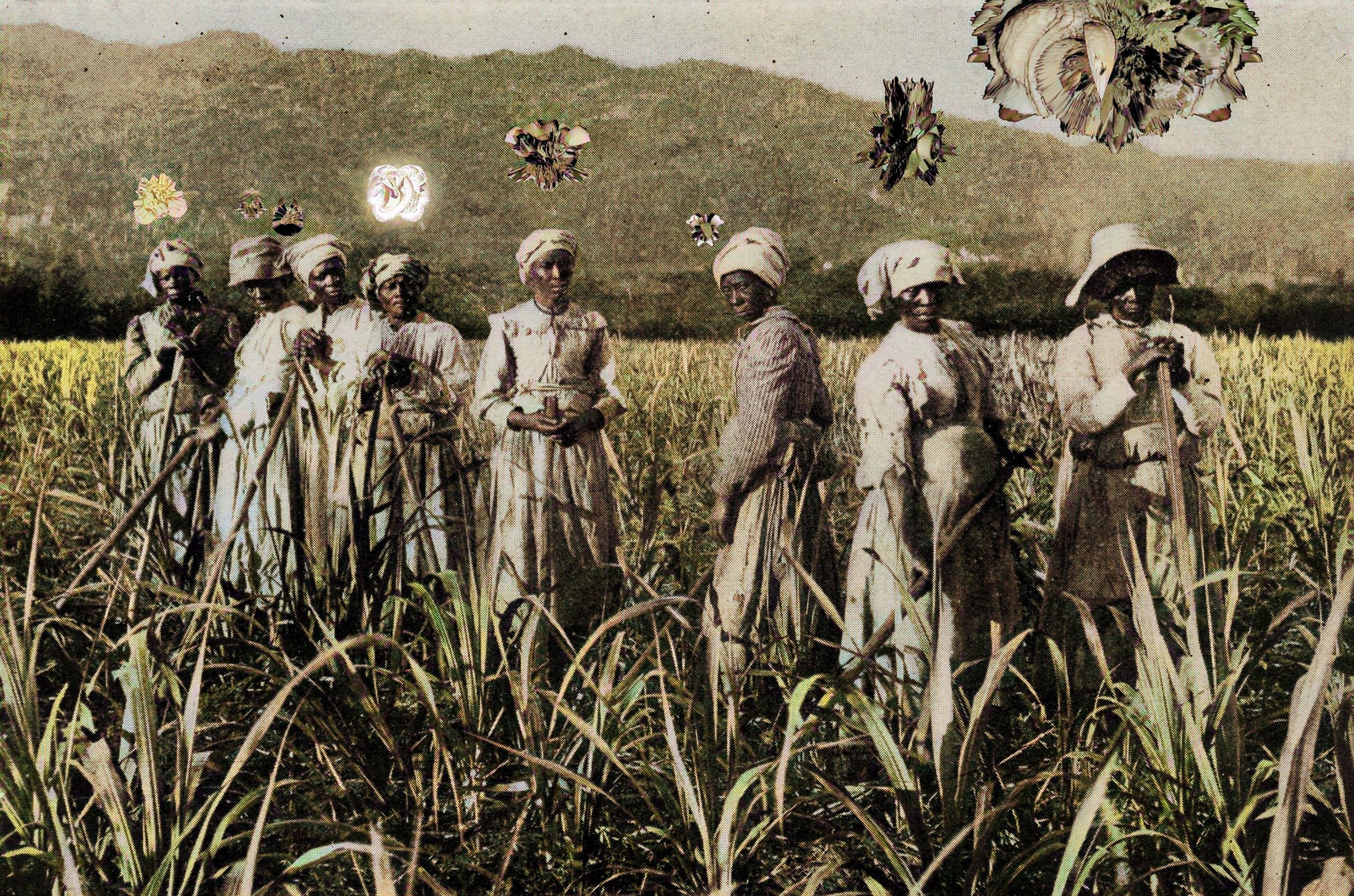
The figure of Michel-Jean Cazabon (1813 – 1888), Trinidad’s first internationally-known painter, looms over many of Warner’s artworks. Cazabon’s portraits of nameless black and brown bodies (his painting titles include MULATTO GIRL and COOLIE GROUP), and his serene, jejune, bamboo-filled landscapes, left out the brutal realities of colonial life. In contrast, you cannot look at Warner’s ‘Augmented Archive 009, Colorised’ (2020) – here, the word ‘colorisation’ has loaded connotations – without contemplating this colonial history. A group of eight women, possibly slaves, stand in an unnamed territory, looking skeptically at the photographer. Warner inserts an object above each of them: brown carnations of varying sizes and luminosity. The object closest to the foreground is the largest, and it hovers over the figure who seems most crestfallen. This re-apportionment within the frame gives a stronger sense of the suffering endured by all, each object drawing attention to the individuality of each woman. Sometimes, Warner’s alterations suggest a desire to help a photograph’s subjects. In ‘Augmented Archive 013, Colorised’ (2020), a dazzling light is inserted in the vicinity of two black children wandering a street on a nameless island, as if to guide them.
*
As Derrida reminds us in ARCHIVE FEVER (1995), archives are concerned with power. For him, the word archive itself is an archive of meanings and associations. Arkhē: commencement and command. Archives are inherently bound to systems of authority, asserting ownership of their contents; they are a place where veneration sits alongside subjugation. Warner’s augmentations speak back to the authorities that stored, categorised and filed the kinds of photographic images he works with.
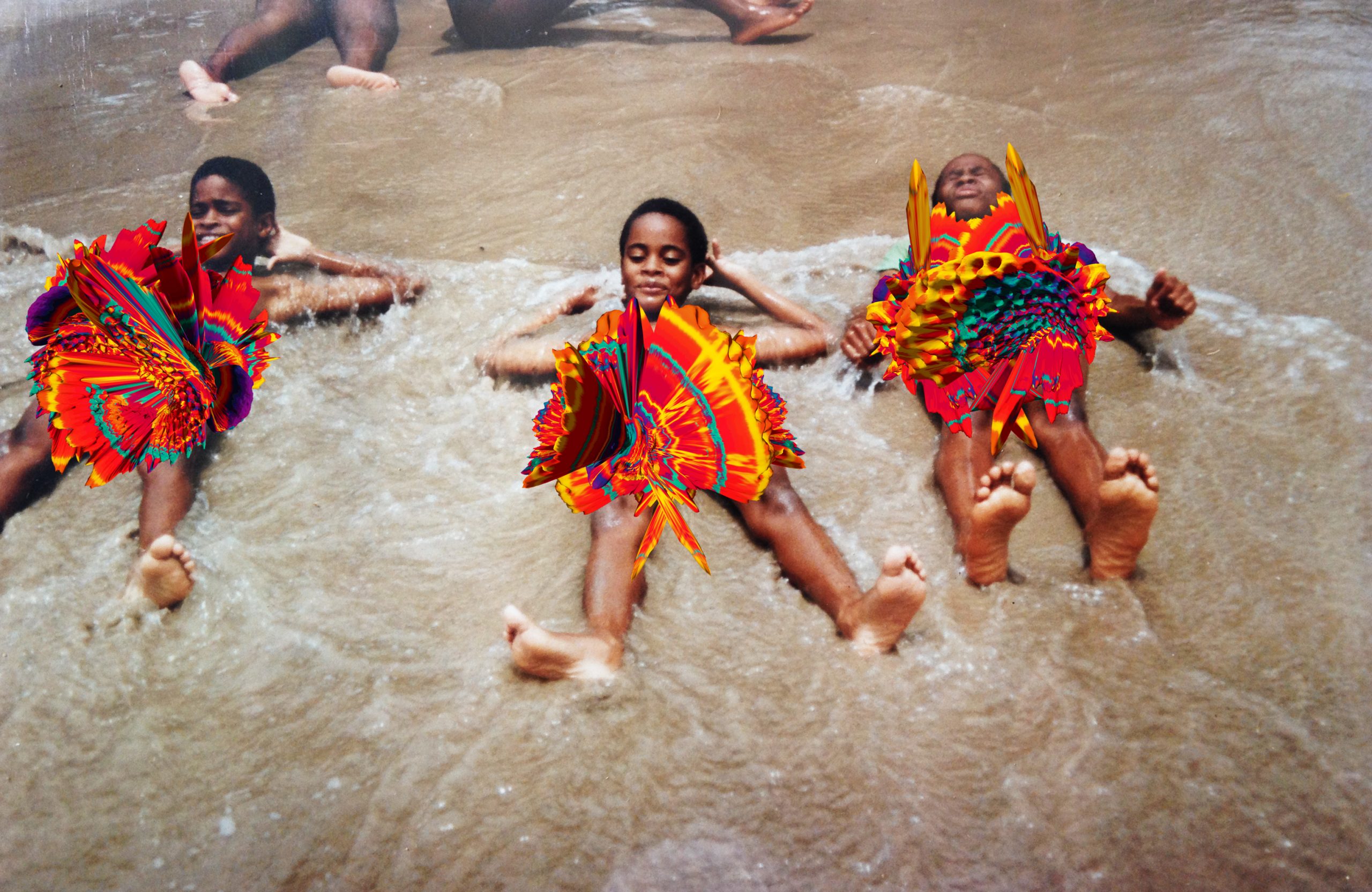
This relationship to authority resonates with Trinidad’s Carnival tradition, in which kinetic movement, based entirely on the motions of the human body, meets colour and form in two days of public displays of revelry. This tradition, long linked to strategies used by slaves to endure slavery and then to celebrate its end, involves coded ways of speaking truth to power, undermining the hold of oppressive systems through visual art and street theatre. Masque as protest, if you will. In the series FAMILY AND FRIENDS (2017), old family photographs are tampered with. Where AUGMENTED ARCHIVE uses found archival images, FAMILY AND FRIENDS looks to the more recent past of Warner’s own life, and does so with an explosion of colour.
In ‘Family and Friends no. 1’ (2017), the placement of the colourful digital objects above the heads of children emerging from the water brings to mind the Fancy Sailor mas from Belmont. Fancy Sailors dress as sea-faring sailors but wear elaborate, surreal headpieces. These symmetrical constructions sometimes feature flowers, birds, feathers and even random objects like telephones. In ‘Family and Friends no. 4’ (2017), a child on the beach might well be playing Kiddies Carnival – the colourful digital object, inserted by Warner, covers the body like a costume made by Rosalind Gabriel, a famed Trinidadian Carnival designer.
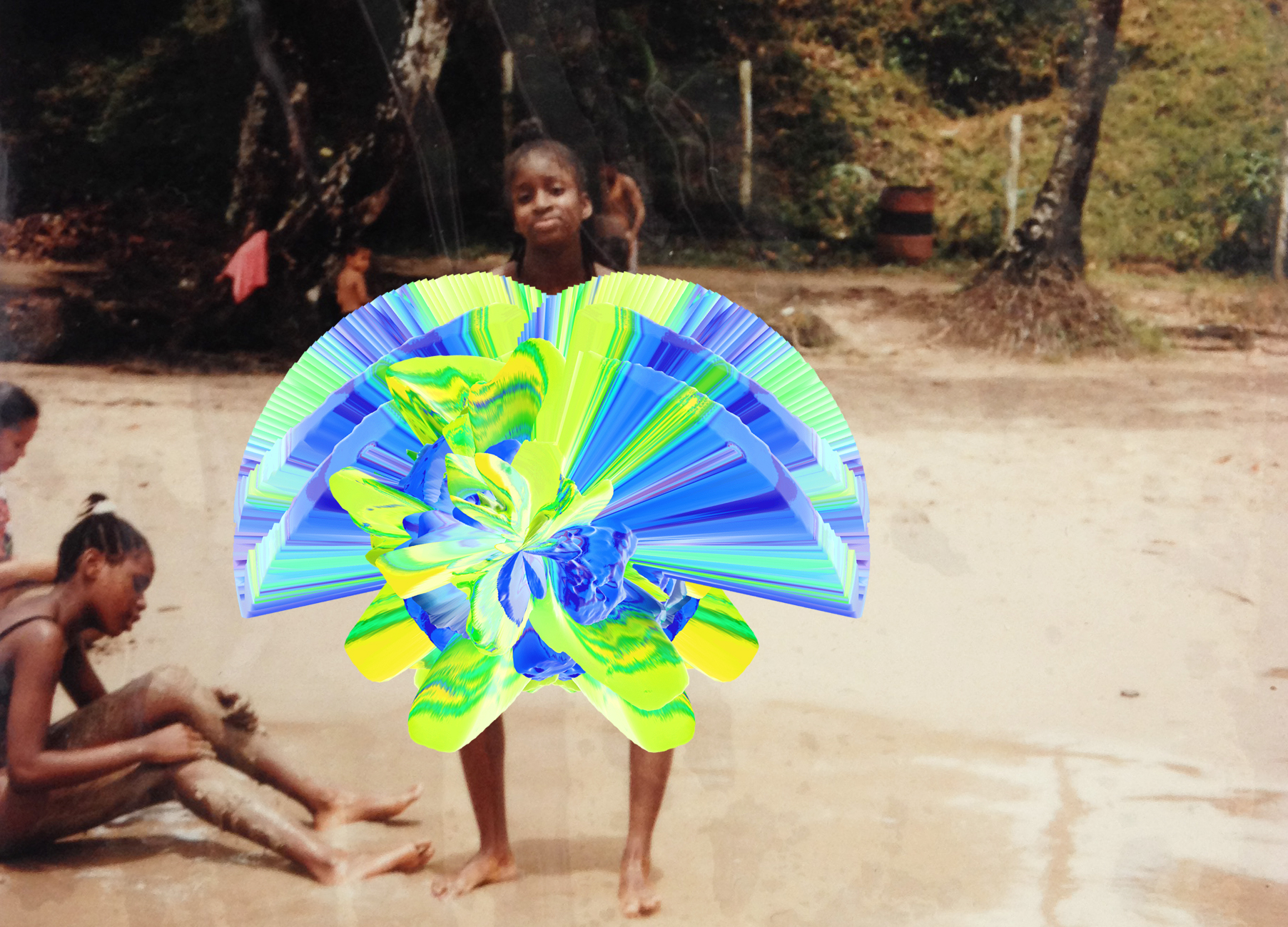
I played mas once with Warner in Port of Spain. We were in a band instigated by the fashion designer Robert Young. Masqueraders were asked to assemble all-white costumes. I ended up using a rainbow-coloured, damaged dress from Young’s fashion line to make my own costume. I was like a moving Warner object set against the monochromatic tones of the other masqueraders. I was at once included and excluded, hidden yet revealed, compliant yet disobedient. I remember roaming the narrow lanes of Belmont in this costume with Warner, chatting, taking pictures and raising the eyebrows of onlookers. My costume was supposed to be thrown away by the end of Carnival Monday and Carnival Tuesday. But for a long time, I kept it for the archives, wanting to hold on to what had already passed.
Featured image:‘Family and Friends no.1’ (2017) Still from GIF, Frame 50. Original Photo by Gerald Warner, circa 1995
Inline image 1: ‘Augmented Archive 013 Colorized’ (2020) Still from video, Frame 54. Original photo by Paul Reboux in Santiago, Cuba circa 1919, Animation and sound by Rodell Warner, 2020.
Inline image 2: ‘Augmented Archive 001 Colorized’ (2020) Still from video, Frame 33. Original photo by Margot Lubinski in Jamaica, 1946. Animation & sound by Rodell Warner, 2020.
Inline image 3: ‘Augmented Archive 009 Colorized’ (2020) Original photograph made in Jamaica circa 1899, Photographer unknown.
Inline image 4: ‘Family and Friends no.2’ (2017) Still from GIF, Frame 38. Original Photo by Gerald Warner, circa 1995.
Inline image 5: ‘Family and Friends no.4’ (2017) Still from GIF, Frame 38. Original Photo by Gerald Warner, circa 1995.
